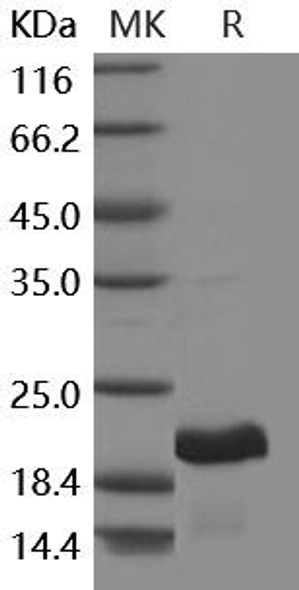Description
| Product Name: | Human Growth Hormone Recombinant Protein |
| Product Code: | RPPB0328 |
| Size: | 10µg |
| Species: | Human |
| Target: | Growth Hormone |
| Synonyms: | GH1, GH, GHN, GH-N, hGH-N,Pituitary growth hormone, Growth hormone 1, Somatotropin. |
| Source: | Nicotiana benthamiana plant |
| Physical Appearance: | Sterile Filtered White lyophilized (freeze-dried) powder. |
| Formulation: | Lyophilized from 1mg/ml solution in PBS 0.05M buffer at pH 7.5. |
| Solubility: | It is recommended to reconstitute the lyophilized�GH in sterile 18M-cm H2O not less than 100�g/ml, which can then be further diluted to other aqueous solutions. |
| Stability: | Lyophilized�GH although stable at room temperature for 3 weeks, should be stored desiccated below -18°C. Upon reconstitution�GH should be stored at 4°C between 2-7 days and for future use below -18°C. For long term storage it is recommended to add a carrier protein (0.1% HSA or BSA). Please prevent freeze-thaw cycles. |
| Purity: | Greater than 97.0% as determined by Analysis by SDS-PAGE. |
| Amino Acid Sequence: | HHHHHHFPTI PLSRPFDNAM LRAHRLHQLA FDTYQEFEEA YIPKEQKYSF LQNPQTSLCF SESIPTPSNR EETQQKSNLE LLRISLLLIQ SWLEPVQFLR SVFANSLVYG ASDSNVYDLL KDLEEGIQTL MGRLEDGSPR TGQIFKQTYS KFDTNSHNDD ALLKNYGLLY CFRKDMDKVE TFLRIVQCRS VEGSCGFAG |
| Biological Activity: | The biological activity of human Growth Hormone is measured by cell proliferation using Nb2-11 cells. ED50�< 0.04-0.1 ng/mL. |
GH is a member of the somatotropin/prolactin family of hormones which play an important role in growth control. The gene, along with four other related genes, is located at the growth hormone locus on chromosome 17 where they are interspersed in the same transcriptional orientation; an arrangement which is thought to have evolved by a series of gene duplications. The five genes share a remarkably high degree of sequence identity. Alternative splicing generates additional isoforms of each of the five growth hormones, leading to further diversity and potential for specialization. This particular family member is expressed in the pituitary but not in placental tissue as is the case for the other four genes in the growth hormone locus. Mutations in or deletions of the gene lead to growth hormone deficiency and short stature.
GH human Recombinant produced in Nicotiana benthamiana plant is a single chain containing 205 amino acids (molecular formula C1025H1570N280O306S7) and 6-His-tag at the N-terminal having the total molecular mass of 22.9kDa.
| UniProt Protein Function: | GH: Plays an important role in growth control. Its major role in stimulating body growth is to stimulate the liver and other tissues to secrete IGF-1. It stimulates both the differentiation and proliferation of myoblasts. It also stimulates amino acid uptake and protein synthesis in muscle and other tissues. Defects in GH1 are a cause of growth hormone deficiency isolated type 1A (IGHD1A); also known as pituitary dwarfism I. IGHD1A is an autosomal recessive deficiency of GH which causes short stature. IGHD1A patients have an absence of GH with severe dwarfism and often develop anti-GH antibodies when given exogenous GH. Defects in GH1 are a cause of growth hormone deficiency isolated type 1B (IGHD1B); also known as dwarfism of Sindh. IGHD1B is an autosomal recessive deficiency of GH which causes short stature. IGHD1B patients have low but detectable levels of GH. Dwarfism is less severe than in IGHD1A and patients usually respond well to exogenous GH. Defects in GH1 are the cause of Kowarski syndrome (KWKS); also known as pituitary dwarfism VI. Defects in GH1 are a cause of growth hormone deficiency isolated type 2 (IGHD2). IGHD2 is an autosomal dominant deficiency of GH which causes short stature. Clinical severity is variable. Patients have a positive response and immunologic tolerance to growth hormone therapy. Belongs to the somatotropin/prolactin family. 4 isoforms of the human protein are produced by alternative splicing. |
| UniProt Protein Details: | Protein type:Secreted; Secreted, signal peptide; Hormone Chromosomal Location of Human Ortholog: 17q24.2 Cellular Component: extracellular space; extracellular region Molecular Function:protein binding; growth hormone receptor binding; growth factor activity; prolactin receptor binding; hormone activity; metal ion binding Biological Process: positive regulation of phosphoinositide 3-kinase cascade; positive regulation of insulin-like growth factor receptor signaling pathway; positive regulation of MAP kinase activity; positive regulation of peptidyl-tyrosine phosphorylation; positive regulation of tyrosine phosphorylation of Stat5 protein; positive regulation of receptor internalization; positive regulation of JAK-STAT cascade; glucose transport; positive regulation of multicellular organism growth; JAK-STAT cascade; response to estradiol stimulus; positive regulation of tyrosine phosphorylation of Stat3 protein Disease: Isolated Growth Hormone Deficiency, Type Ia; Isolated Growth Hormone Deficiency, Type Ib; Isolated Growth Hormone Deficiency, Type Ii; Kowarski Syndrome |
| NCBI Summary: | The protein encoded by this gene is a member of the somatotropin/prolactin family of hormones which play an important role in growth control. The gene, along with four other related genes, is located at the growth hormone locus on chromosome 17 where they are interspersed in the same transcriptional orientation; an arrangement which is thought to have evolved by a series of gene duplications. The five genes share a remarkably high degree of sequence identity. Alternative splicing generates additional isoforms of each of the five growth hormones, leading to further diversity and potential for specialization. This particular family member is expressed in the pituitary but not in placental tissue as is the case for the other four genes in the growth hormone locus. Mutations in or deletions of the gene lead to growth hormone deficiency and short stature. [provided by RefSeq, Jul 2008] |
| UniProt Code: | P01241 |
| NCBI GenInfo Identifier: | 134703 |
| NCBI Gene ID: | 2688 |
| NCBI Accession: | P01241.2 |
| UniProt Related Accession: | P01241 |
| Molecular Weight: | 22.3 |
| NCBI Full Name: | Somatotropin |
| NCBI Synonym Full Names: | growth hormone 1 |
| NCBI Official Symbol: | GH1�� |
| NCBI Official Synonym Symbols: | GH; GHN; GH-N; GHB5; IGHD2; hGH-N; IGHD1A; IGHD1B�� |
| NCBI Protein Information: | somatotropin |
| UniProt Protein Name: | Somatotropin |
| UniProt Synonym Protein Names: | Growth hormone; GH; GH-N; Growth hormone 1; Pituitary growth hormone |
| Protein Family: | Growth hormone |
| UniProt Gene Name: | GH1�� |
| UniProt Entry Name: | SOMA_HUMAN |










